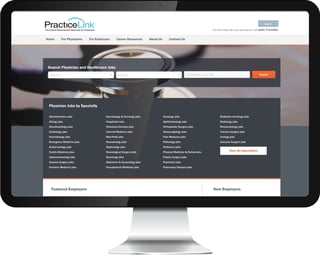
As a physician recruiter, your work is strategically important: attracting the most qualified candidates to fill current and anticipated vacancies.
As you investigate the best physician recruitment solutions to help you meet your goals, here are five acronyms you should know—and how each relates to your work.
Applicant Tracking System (ATS)
An ATS is a software application that helps recruiters manage the hiring process. Health care organizations use a variety of methods to track applicants, from Excel to sophisticated systems integrated with their other recruitment tools.
Shawn LeMar, interactive marketing manager from CHG Healthcare, says, “There are quite a few things physician recruiters could put into an ATS depending on how detailed you want to get, such as licensing, credentials, etc. There also may be things you don’t need to track, such as where the physician went to school or where they did their residency. The main thing is that you have some type of an ATS to keep you organized.”
PC Magazine sums it up this way. “The best job candidates don’t all come from the same place. …All of these outlets provide troves of data—all of it unstructured and in different forms. All of this data needs to be brought together in one place for your hiring teams to make sense of it. That information overload is why companies looking for a solution to help them find, recruit, and hire the best job candidates should consider purchasing applicant tracking software.”
Before purchasing a stand-alone ATS, physician recruiters should first check with their primary physician recruitment platform to see what options are available as part of an integrated package. Ask how the tool can help you track expenses, manage credentials, store files and report on progress.
Recruitment Marketing System (RMS)
Building relationships with physicians—and starting that relationship early—can be the key to landing the right fit before your competition does. Having the tools to get a jumpstart that relationship can be a great benefit. This is where a Recruitment Marketing System (RMS) can help.
A RMS helps you not only find, but also interact with potential candidates in a relationship nurturing approach. Tools found in an RMS system can help physician recruiters easily tailor messages to potential candidates by how they interact with your messaging. For example, how many times did they open your emails or click through to the content—and how should they hear from you next?
Pay Per Click (PPC)
Pay Per Click (PPC), is an advertising model through which the advertiser is charged when their ad is clicked. In a PPC model, you will pay a certain amount each time your ad is clicked—the Cost Per Click (CPC). The CPC varies depending on who else wants to be in that space based on that keyword search. Advertisers bid for spots similar to an auction.
PPC campaigns can result in a physician clicking through to your organization's website, a job opportunity, an article, etc.
“As a physician recruiter, you need to identify what you want the person to do, which could be contacting you or completing a form,” LeMar says. “That’s where the click needs to lead to.”
Cost Per Application (CPA)
Cost Per Application (CPA) or Cost Per Lead (CPL) is a model in which you pay a fee when there is a sign up from a candidate, a job apply completed, or another direct response to an advertisement.
Klipfolio defines a lead in this scenario as “an individual that has expressed interest in your product or service by completing a goal.”
Recruiters looking to articulate the CPL of a flat-fee physician recruitment platform can divide the total platform price by the number of inquiries received throughout the contract time.
Cost Per Hire (CPH)
The Cost Per Hire (CPH) metric measures the costs associated with all the necessary activities of hiring a physician candidate. The CPH includes every part of the recruitment process—not just one tool or piece of the process.
The measurement of your organization’s overall CPH—or even just the physician recruitment department’s—can be an important way to evaluate efficiency and plan for budgeting. Ask your physician recruitment platform how it can help you track your cost per hire, such as making it easy for you to record expenses for food, lodging, travel—and to create reports from the data.








